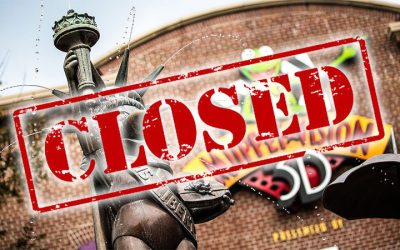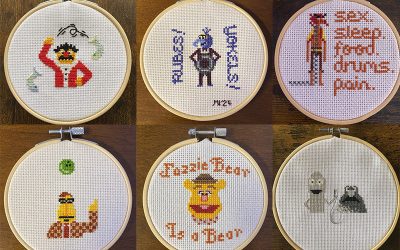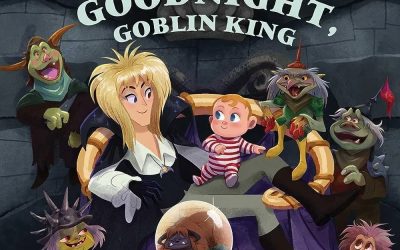We are proud and excited to welcome back ToughPigs founder Danny Horn for a feature looking back at the earliest days of the website for Muppet fans who grew up! For more from Danny, be sure to check out his newest venture Superheroes Every Day!
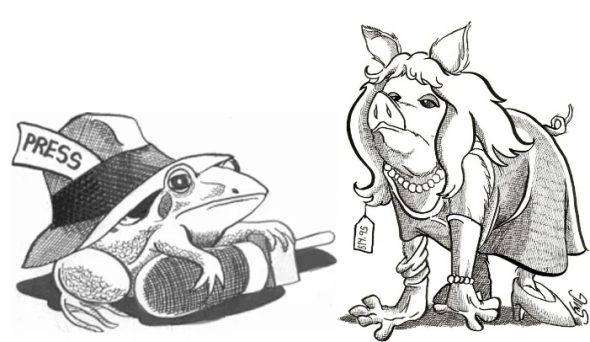
Back in the day, when I was young and running a website seemed like a good idea, people would ask me, why is your site called Tough Pigs? I would explain that it’s a website for Muppet fans, with kind of an adult sensibility. Well, that’s interesting, they would say, eyebrows at this point decidedly arched, but why is it called Tough Pigs? So I would mumble something about Miss Piggy, and then I would buy them a drink or pay the parking ticket, or whatever it was we were engaged in when I brought it up.
And they were right, of course, to be suspicious of a name like Tough Pigs, which sounds like a motorcycle club for gay farmers. It’s a ridiculous name for a Muppet fansite. It’s even more ridiculous that User:Toughpigs is still my username on Wikipedia, the non-profit website that I now work for, so all these years later I am still having that conversation with my co-workers.
But there is an actual answer to that question, which is that I didn’t think I was creating a Muppet fansite at the time; I thought that I was writing a book. It was the year 2000, and what I thought the world needed was a self-published film-crit book called Gentle Frogs/Tough Pigs: A Queer History of TV’s Favorite Puppet Characters.
Okay, a lot to unpack there.
The inspiration for the book was the fact that once I started meeting Muppet fans on the internet in the late 90s, I found that a strikingly large percentage of the guys were gay or bisexual. I don’t know if that’s still the case, in this new world of the 2020s where I’m informed that pretty much everybody under the age of 30 is genderfluid and non-binary, but in the 1990s there was still a thing called gay dudes, and I was delighted to discover that quite a few of them wanted to talk about The Muppet Show.
At the time, things were pretty rough for LGBTQ people in American public life. Gay marriage was still 15 years away from being legal, and same-sex relationships were generally considered unimportant and unworthy. There were sodomy laws in many states that made gay sex illegal, queer people were banned from the military and the Boy Scouts, and people were even more vicious about trans people back then than they are now. Naturally, I was pissed off about this basically all of the time, and when people on the internet said that Ernie and Bert couldn’t be seen as gay because Sesame Street was a kids’ show and you weren’t allowed to talk about gay people when kids were around, I figured that I had to step in and do something about it.
You see, when I was in college I got a four-year degree in post-structuralist literary theory, which is basically a kind of impenetrable jargon that makes everything that you say sound intelligent, even if you don’t speak French. The big advance in literary criticism at the time was Queer theory, which was more fun than Marxist theory and New Historicism because you got to talk about drag queens and make people uncomfortable.
There were several enjoyable books published in the 90s that applied queer theory to sitcoms and cartoons — Making Things Perfectly Queer: Interpreting Mass Culture (Alexander Doty, 1993), Reading the Rabbit: Explorations in Warner Bros. Animation (ed by Kevin S. Sandler, 1998) and Tinker Belles and Evil Queens: The Walt Disney Company from the Inside Out (Sean Griffin, 2000).
So I got the idea that it would be fun to write a queer theory book about the Muppets, hence: Gentle Frogs/Tough Pigs: A Queer History of TV’s Favorite Puppet Characters, because you always needed a baffling phrase as the title, followed by a colon and an explanation of what the hell you were talking about. The book would look at why queer people seemed to be drawn to the Muppets, and vice versa.
I registered the domain ToughPigs.com, and my plan was that I was going to self-publish the book, and then promote it and sell it on the website. But then I started posting Muppet news on the site, and people started to read it, and it turned out the website was more fun than the book, so I never bothered to actually write very much of it.
But I still have all my material for the book in a big green binder, with everything that I did manage to write, and all my notes and sources. I had the structure planned out, and the actually written part is 29 pages long, with lots of gaps that I was planning to expand on. And then there’s maybe 100 pages of notes, including transcripts of Miss Piggy interviews and sadomasochistic Wilkins Coffee commercials.
Looking back at this material now, it’s amazing how earnest and serious I was about it all. There aren’t really any jokes in it, except for the larger meta-joke of how ridiculous the entire project is. This was 30-year-old Danny at the turn of the century, frustrated and pissed off, and ready to pick a fight with straight people over trivial things that I cared a lot about.
Once I started actually writing for the Tough Pigs site, though, I developed a tone that was funny and sarcastic and very personal, and the fake-academic Gentle Frogs/Tough Pigs material would have felt out of place. It was also out of date by 2003, when the Broadway musical Avenue Q explored the Ernie/Bert relationship, expressing a lot of the ideas that I would have wanted to say, but with jokes and musical numbers. So the book got left behind.
But I’ve made references to it over the years, and I guess some people are curious to know what the book would have been like. So now, in honor of the site’s 20th anniversary, I’m going to share with you some of the book I never wrote.
So here goes. The book had six chapters:
Chapter 1: Toward an Unnecessary Theory of Muppet Sexuality
Chapter 2: Oral History
Chapter 3: Home Makers
Chapter 4: That Gay Romance
Chapter 5: Something Better
Chapter 6: The P-Word
I’m going to give you a big chunk of the first chapter, and then some excerpts from the following chapters.
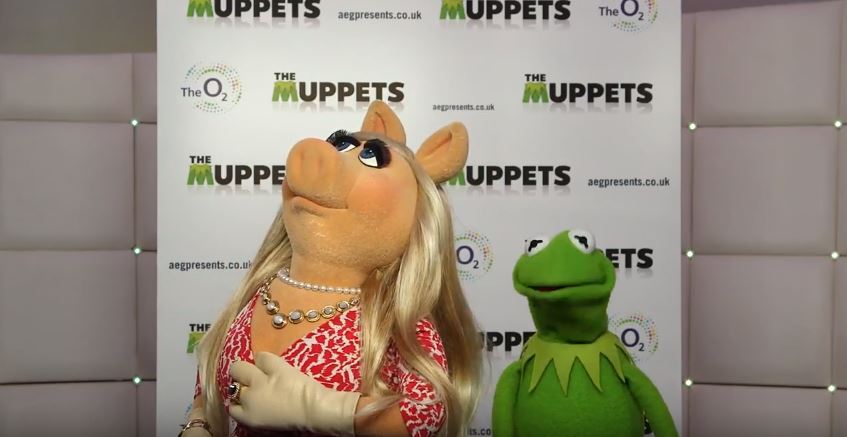
Chapter 1: Toward an Unnecessary Theory of Muppet Sexuality
This book is, to some extent, an argument about inclusion. Queer people are constantly facing conflicts of inclusion and exclusion, everywhere we go — in our families, schools, jobs, and communities. We look for ways to be visible, and are constantly pressured to be invisible. This is true within the Muppet fan community as it is everywhere. Heterosexual identification is considered fair game for discussion, but sometimes, queer identification is derided as “reading too much into things.” Muppets are regarded as “innocent” — a utopian pre-sexual childhood state in which sexuality does not exist. In this pure world, mothers and fathers and hetero lovers exist — Gordon and Susan, Kermit and Miss Piggy — but love between two men or two women is an unwelcome adult intrusion. This view posits a perfect Edenic world in which queer people simply do not exist.
It bears some relationship to the utopian future of Gene Roddenberry’s Star Trek in which racial conflicts have been “solved,” and people of all nations and races work alongside each other in harmony. Like Star Trek, Sesame Street and The Muppet Show create fictional worlds in which people of all races and species live together happily. But the Star Trek future has also apparently “solved” the problem of homophobic conflict — by eliminating all the queer people. Does Sesame Street do the same thing, by looking back to a nostalgic childhood past? Is it possible that we can only be happy and carefree in a world where there are no queer people?
My argument, obviously, is to resist that view, which is exclusionary and fundamentally incorrect. There are simply too many queer people who love the Muppets; there must be something here that appeals to us, and it’s not a regressive fantasy of self-extermination. This argument rests on one essential truth: To love something that despises you is soul-killing. This project seeks to look closely at what I find in the Muppets — to try to put my finger on that elusive queer appeal — and to inspire other queer Muppet fans to look at how they find themselves and their stories reflected in the Muppets.
And now let’s get things started. I’ve had conversations with Muppet fans about queer readings of the Muppets for years, and there are three persistent counter-arguments that come up again and again. The first argument is that Muppets are puppets; they don’t have sexual organs and therefore don’t have sexuality. They’re sexual innocents, living in a pure childhood state of pre-sexuality. If that fails, the second argument is that Every Muppet is heterosexual; opposite-sex couples can be in love, but same-sex couples are just friends. Finally, when things get really grim, the last argument is that Jim Henson and company didn’t mean it that way; you’re reading things into it that they didn’t intend. These are valid points that need to be addressed.
To begin with, love and sex do exist in the Muppet world. Muppet fans and the general audience often speculate about love relationships between Muppet characters, with the obvious example being Kermit the Frog and Miss Piggy.
The boundaries of Kermit and Piggy’s relationship are always being explored, and I could argue that one of the main pleasures audience members get from the relationship is the amusing uncertainty of not being able to pin down exactly what that relationship is. Are they dating? Are they married? Do they have sex? Will there ever be bouncing baby figs?
The 1984 film The Muppets Take Manhattan ends with Kermit and Miss Piggy being married on stage during a Broadway show. In the promotional tour for the movie, multiple interviewers asked the characters if Kermit and Piggy are married in “real life” as well as in the movie, with Piggy asserting that they were, and Kermit denying it. The way that the couple discussed their “private lives” was so engaging and fascinating that it set the tone for future appearances well into the next decade, with interviewers Larry King (1993), Regis Philbin (1996) and Jay Leno (1996) still grilling the imaginary couple for details of their domestic life.
For queer people, the question of inclusion in the Muppet narrative worlds is complicated by the generally understood rules of American family programming, which don’t allow for open discussion of sexual desire. The performers and writers are adults, with an adult sense of humor that includes an interest in sexual humor — but in deference to the tastes of the family audience, the sexual content gets expressed through innuendo and connotation rather than direct sexual references. Kermit and Piggy crack sexual jokes in interviews, but usually in late-night spots when the children are presumed to be asleep. The most obvious example of a coded gay reference is Gonzo’s admission to Kermit in Muppets From Space that “I’ve always had alien tendencies” — direct enough for the adults in the audience to get the joke, but disguised enough that young children would miss it. Queer people recognize and identify with this tactic; we’ve all done it ourselves. Every queer person has spent at least some time hiding queer desires, especially when the children are around.
The experience of being in the closet also informs our queer reading of the concept of “friendship” in the Muppet narrative world. Most of us have had the experience of introducing a romantic/sexual partner as a “friend”, or having someone ask about our “friend” — so it makes sense that we may view “special friendships” between, say, Bert and Ernie, or Dr. Bunsen Honeydew and his assistant Beaker, through a queer leans. Because there are so few overt romantic relationships, and almost no overt expressions of sexuality in the Muppet world, the boundaries blur between “friendship” and “love,” and space opens up for queer interpretations of the relationships between Muppet characters.
This taxonomy of “friendship” and “love” is important. If I’m suggesting that viewers can see queer relationships in the Muppet world — for example, between Bert and Ernie, Bunsen and Beaker, Gonzo and Rizzo — then we need to have some way of distinguishing between a “romantic/sexual” (queer/homosexual) relationship and a “best friends” (homosocial/bonding) relationship. If the boundaries between “friendship” and “love” are so blurred, is it possible to posit romantic relationships between any two characters who share screen time? (Kermit and Fozzie Bear? Red and Mokey Fraggle? Floyd Pepper and Animal?) Using such a broad definition of “queer relationship” makes it meaningless. So where can a distinction between “friends” and “love” be drawn?
I think to draw such a distinction, we need to focus on emotional intimacy rather than sexual/physical contact. By saying that Bert and Ernie can be read as queer, I don’t mean that the two characters “have sex” in some imaginary narrative space that exists just off-camera. In fact, the whole concept of physical intimacy between Bert and Ernie feels to me crude and awkward — it’s hard to imagine them kissing, those big open lipless mouths bumping into each other. It’s a weird, unpleasant image, and I apologize for putting it in your head, but there we are. If we insist on on-screen evidence of physical intimacy, then there are practically no relationships in the entire Muppet universe. Even Kermit and Miss Piggy, the couple who most represent romantic love, only kiss a few times on-screen in the entire twenty years between The Muppet Movie and Muppets From Space. It’s American family programming, so there isn’t a lot of bumping and grinding to be seen.
Therefore, much of the basis for a queer reading of Muppet relationships is the emotional intimacy between the characters. Ernie and Bert don’t kiss, but the emotional bond between them is incredibly powerful — so powerful, in fact, that practically every scene they have is about testing and defining their friendship. It’s almost impossible to think of one character existing without the other. Imagine Ernie and Bert “growing up” someday — and the mature Ernie marrying a female Muppet and having a family, getting his own place and not living with Bert anymore. It’s tragic. It doesn’t bear thinking about. [Note from the future: Except in Avenue Q, which thought about it a lot.]
I would posit the existence of “primary emotional bonds” between Muppet characters that stands in place of romantic/sexual relationships in the family-programming universe — and that it’s this primary bond that exists between Bert and Ernie. There are two elements that make this “emotional bond” different from simple friendship: #1) The relationship is primary and exclusive, more important than any other relationship or goal in their lives. #2) The relationship is tested in a narrative, where the only satisfying resolution of the narrative is the relationship surviving intact. Musical comedy storylines invariably follow this narrative structure — the main couple is kept apart, but at the end, they find each other and fall in love, or get married. The “happy ending” needs to involve the couple united; any other resolution is unacceptable.
Using this definition, we can see the difference between a “romantic” relationship (Kermit and Piggy) and a “best friends” relationship (Kermit and Fozzie).
In Piggy’s life, obviously, Kermit is her primary emotional bond; whether he feels the same for her is the source of their comic romantic conflict. Their relationship is tested time and again — the films The Great Muppet Caper, The Muppets Take Manhattan and the second half of Muppet Treasure Island have traditional musical-comedy structures, with the couple united, split apart and then reunited for a kiss at the fade-out.
Looking at Kermit and Fozzie, they’re obviously close friends — especially in the first half of The Muppet Movie, which is mostly concerned with their best-buddy road trip — but Fozzie is clearly less important to Kermit than Piggy is. The Kermit/Fozzie relationship is never tested — like all best friendships, it seems easy, eternal, uncomplicated. When Kermit sends all of his friends away in The Muppets Take Manhattan, Piggy is the one who stays in New York and leads the search for the amnesiac Kermit, while Fozzie is grouped with the rest of the gang.
This standard of “primary emotional bond” is what I’ll be using in the following chapters to locate the sites of queer identification among the Muppet characters. Floyd and Animal, to use an example cited above, are clearly friends and fellow band members, but their friendship is neither primary nor exclusive, and the relationship is not tested in any narrative. (Although the relationship between Floyd and Janice is also not tested by narrative, and fan speculation about their hetero relationship is based almost entirely on the two characters sitting next to each other in the theater in The Muppet Movie — an example of how straight people are always reading too much into things.) But what about Bunsen and Beaker? They’re clearly primary to each other, but is their relationship tested through narrative? What about Gonzo’s relationships with Camilla the Chicken and/or Rizzo the Rat? These are the questions that this book will explore.
[Then there’s another two and a half pages about the question of “intention”, and whether it matters what the creators wanted to suggest. It gets into post-structuralist reception theory, so I’ll spare you. This is the one paragraph that I think is interesting:]
As we’ll see in detail in a later chapter, Henry Beard — the author of the 1981 best-selling book Miss Piggy’s Guide to Life and the text for the 1984 book Miss Piggy’s Treasury of Art Masterpieces from the Kermitage Collection, and co-author of the 1982 record album Miss Piggy’s Aerobique Exercise Workout Album and TV special The Fantastic Miss Piggy Show — clearly expressed a self-consciously camp/queer sensibility that the writers of the 1984 film The Muppets Take Manhattan did not. Does that mean that Miss Piggy is queer in The Fantastic Miss Piggy Show and not queer two years later in Manhattan? Would it matter if we knew that Beard intentionally drew on the comedic traditions of queer camp when writing for Miss Piggy? Would it matter that the actor playing Miss Piggy is a man, and that the standard for romantic relationships in the Muppet world is the story of a drag queen slowly wearing down the resistance of the heterosexual man that she loves?
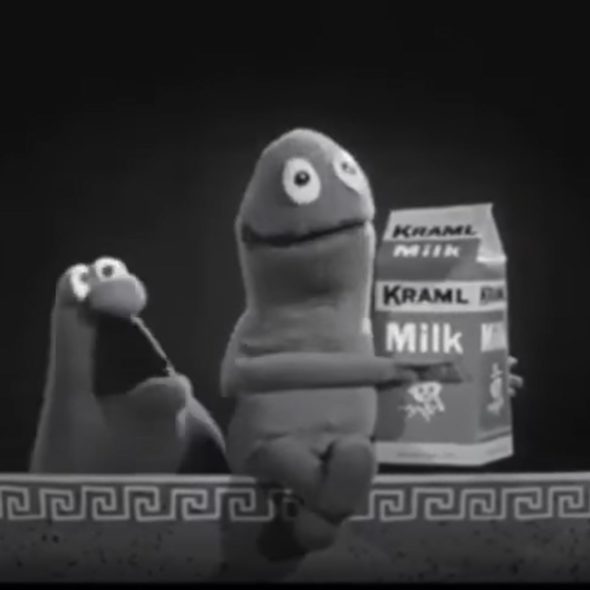
Chapter 2: Oral History
Okay, enough of that. The second chapter was about Jim Henson’s early work: Sam and Friends, the variety show sketches and the commercials, especially for Wilkins Coffee and Kraml milk.
There’s a lot of oral and physical humor in Henson’s early work. The “Inchworm” sketch had Kermit eating a series of worms until the end, when he’s consumed himself, in the enormous open maw of a monster. The Koozebanian reproduction sketch describes the sex act as an orgasmic explosion, destroying the parents in the creation of new life. Both the “Hugger Mugger” and “Java” sketches involve small, timid “feminized” creatures triumphing over larger, more masculine bully characters by explosively “shooting” smoke at them. Kermit sings “I’ve Grown Accustomed to Your Face” as Yorick begins to eat his foot.
The Wilkins Coffee commercials are especially body focused, tiny little snippets of sadomasochistic narrative that almost invariably end in a sudden, impulsive burst of violence. I also make a big deal about this commercial for Kraml milk:
WILKINS: I love Kraml milk.
WONTKINS: You should see a psychiatrist!
WILKINS: I did! He’s the one who told me about Kraml. I used to love my raincoat.
There’s some talk about the La Choy Dragon intruding into the supermarket and suburban home, “creating a slice of alternity”, which is very late-90s lit crit. The chapter ends with:
Is it possible that this release of anarchic/erotic energy that’s such a vital part of the early sketches is part of the reason why it was so hard for Henson to sell his pitches for a weekly network Muppet show? All these characters exploding and eating each other — it was fine for a three-minute sketch, but this energy needed to be contained and controlled. It was only after Henson proved that he could tone down the physicality in Sesame Street that he was allowed to make pilots for his Muppet variety show.
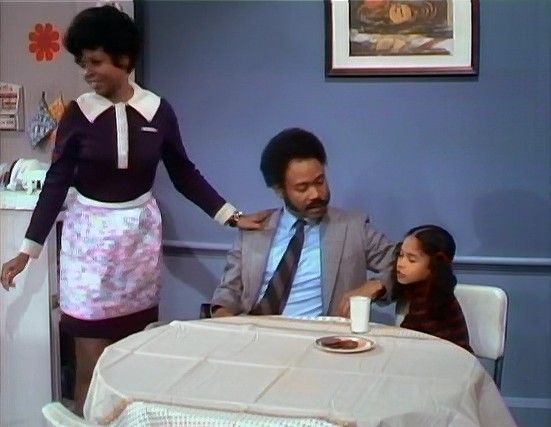
Chapter 3: Home Makers
And then on into Sesame Street, which welcomes preschoolers into an imaginary geography, with strange permeable boundaries and so on. I was obsessed with the first episode of Sesame Street, and I typed up a transcript and then wrote all over it with little notes about transgression and family structure. That turned into the following set of scribblings, which would have been the basis for a lot of chapter 3:
Six sites of instability and ambivalence in the Sesame Street premiere:
#1. Reality vs TV show
Are the characters living continuous “lives”, or are they aware of being fictional? (i.e., talking to the camera, “seeing” bits of film, participating in “Everybody Wash” jump cuts)
Is there a continuous geography (Hooper’s store, 123 porch, Gordon & Susan’s apartment) or discontinuous (“wall” space, zoo film)?
Do the characters in the inserts (Carol Burnett, Solomon Grundy) exist in the same narrative geography as the residents of the Street?
#2. Fluid identity
Do the human, puppet and cartoon characters have the same “status”? Are they treated differently? Are they all “real”?
Do the Anything People “try on” identities, or do they each have an essential core identity that they can recognize?
Is the “monster” that menaces Kermit dangerous, or childlike?
#3. Rehearsed vs improvised
Is there a script? People talk over each other and ad-lib.
Kids invade with “inappropriate” shouts and comments.
#4. Ambivalence about gender, domesticity and child-rearing
Gordon seems ambivalent about his (feminized) role as educator/care-taker, which is expressed through “adult” asides, sexual innuendo, takes to the camera, mocking Ernie.
Susan is identified only as caretaker, with many references to making and distributing cookies. She is very comfortable with kids.
Jenny knits — and when Sally joins her, Gordon leaves the scene (and doesn’t interact with Sally after that).
Bob is the “shop” teacher (later in the series, music teacher). Gordon and Bob laugh at Buddy and Jim, who fail to perform a masculine task.
But the puppets are much more fluid in their gender presentation — Ernie is very emotional, cries, expresses passion. Anything People “try on” gender roles. Big Bird is physically dominant, but vulnerable and emotional.
#5. Ambivalence about sex and reproduction
Sally makes an ad-lib comment about Big Bird’s egg, Gordon covers it up.
Human woman in film insert is shocked by pigs in baby carriage.
Anything People mom says she likes men with mustaches, Gordon laughs.
Gordon kisses Susan with “hungry” innuendo.
#6. Ambivalence about family structure and love
Ernie and Bert are “friends”, but they live together and have no shame about bathroom intimacy/nudity.
Ernie “loves” the number two, and its significance to him and Bert.
The Anything People have an unstable (but loving) family structure.
Essentially, every major element of the show is fluid and problematized.
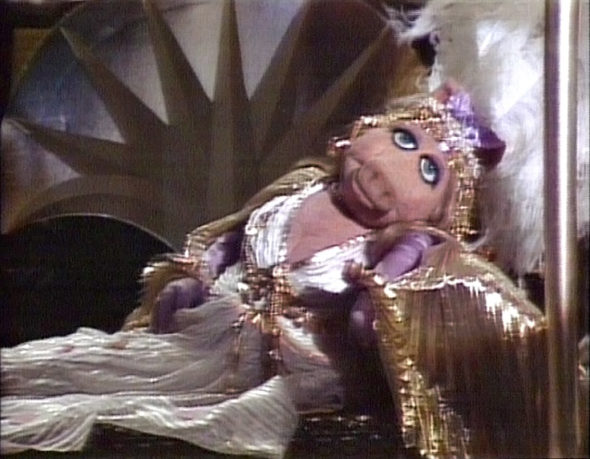
Chapter 4: That Gay Romance
Chapter 4 was about Kermit and Miss Piggy, opening with the lines from “Pig Calypso” in the Bob Hope episode of The Muppet Show:
Pigs, pigs, pigs, pigs, having fun.
Laughing, singing, in the sun.
Yoo-hoo, Piggy, come and dance.
Tell us of your gay romance.
Which was basically a gift to me personally.
This chapter digs into the “Miss Piggy as drag queen” idea, talking about the tradition of carnival and performers crossing gender boundaries in unexpected ways. This is my introduction to the concept of camp:
“Camp” is hard to define, but if you can imagine how Frank Oz must have felt, performing Miss Piggy in the 1979 special The Muppets Go Hollywood, making a grand entrance concealed inside a divan carried into the famous Cocoanut Grove nightclub by oiled, half-naked musclemen and singing “Baby Face” while Nancy Walker and Anne Bancroft applauded, then right there you’ve got a good working definition.
Then there would be a lot of material on Henry Beard’s influence as mentioned above, looking perhaps too closely at Miss Piggy’s Guide to Life and The Fantastic Miss Piggy Show, and comparing it to Judy Garland and Divine and who knows what else.
There would also be a section about Kermit and Piggy’s discussion of their “wedding” in the promotion for The Muppets Take Manhattan, including this:
This brings the Muppet performance-conflict narrative into the familiar “real world” of publicity and celebrity promotion in a particularly pleasurable way. This serves to reinforce the illusion that the Muppets are “real”, and casts some cynical doubt on the “real-world” marketing of celebrities’ private lives. This was around the time that Rock Hudson’s AIDS diagnosis was made public, and people were made even more aware that the “non-fiction” backstage stories printed in entertainment magazines are a crucial part of the romantic fiction sold by movie studios. Consciously or not, Kermit and Piggy’s public squabbles about their marital status parody public suspicions about the marriages of celebrities assumed or rumored to be gay, including Michael Jackson, Richard Chamberlain, Richard Gere, Anthony Perkins and Tom Cruise. Are they really married? Or is it just part of the show?
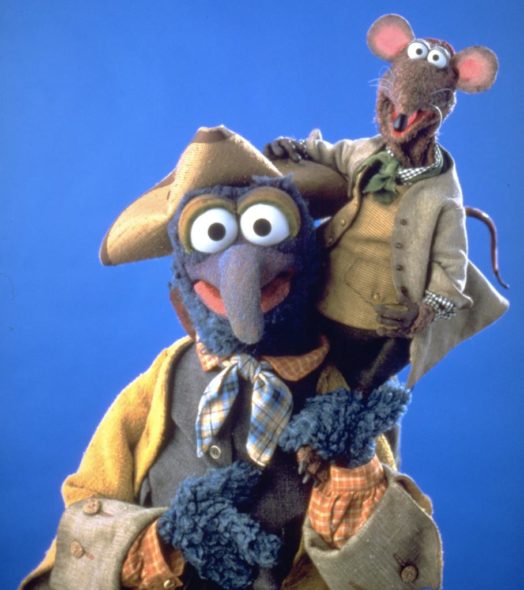
Chapter 5: Something Better
This chapter was about Gonzo, who’s just been sitting there all this time waiting for somebody to write a queer theory book about him. This was 21 years before Gonzorella, of course, so all I can say is that I had dibs on the idea. I’ve got notes about Gonzo’s relationship with pain, his flamenco-dancing block of cheese who turns out to be male, his flirtation with Big Bird, and his struggle to hold on to love like invisible strings.
Then there’s a whole section about Muppet Treasure Island, the story of an adolescent boy coming of age and struggling with two different versions of how to be a man — and ultimately choosing the feminized path. Long John Silver tries to take Jim Hawkins’ father’s place as a father/protector/seducer, and Bad Polly and Clueless Morgan are a predatory “rough trade” couple who have an S/M scene in which they “torture” Gonzo, who enjoys it.
Here’s the best part:
The use of “treasure” is especially important here. For much of the film, the search for treasure is a manly enterprise, with the early dark scenes of the pirate captain, crocodiles, and cold-blooded murder. But three-quarters of the way into the film, when they find the treasure, it’s been stolen from the pirates’ hiding place and is now guarded by Piggy, the fabulous jungle queen who makes a Busby Berkeley entrance surrounded by fans and feathers. The first glimpse we get of actual gold is displayed on Piggy’s body, as part of her outrageous costume; the masculine chests of stolen pirate gold are transformed into feminized jewelry. All of a sudden, this “manly” endeavor starts to look like a particularly harrowing shopping trip for some fabulous accessories.
This masculine/feminine “treasure” subtext is made more explicit during the “Love Led Us Here” number. The comic romance between Kermit and Piggy is paired with the pirates’ love for gold — and each other. (The scene includes a long shot of two pirates running into each other’s arms in a comic take on traditional romantic movie imagery.) The boys’ adventure story about hunting for gold gradually transforms into a chick flick, a quest for love — and when the pirates touch gold, it has an immediate feminizing influence on them.
Phew. So then it goes on, believe it or not, to analyze the Muppet Treasure Island Sing-Along video at some length, and then obviously a section on Muppets From Space that you can basically write yourself by this point.
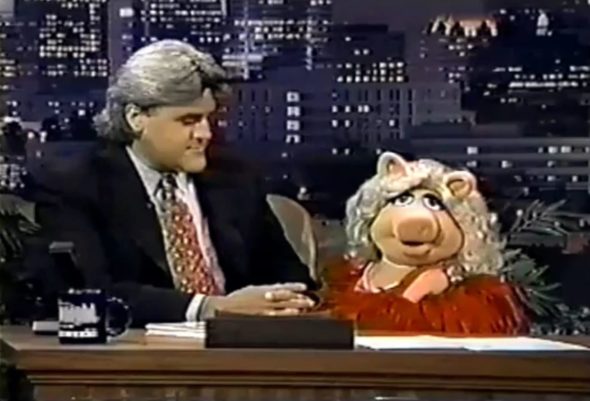
Chapter 6: Saying the P-Word
This chapter was about the essential identity tension about whether the characters know that they’re puppets or not, especially outside of the show in public appearances. There’s some material on the “puppet panic” moment in the Jim Henson Hour episode “Secrets of the Muppets”, and then quite a bit about Miss Piggy’s 1996 appearance on The Tonight Show with Jay Leno.
Here’s the interesting bit:
In all of the Muppet interviews, there is constant “identity-tension”. The humor is built around the characters’ consciousness/unconsciousness of their true “non-real” nature. In that moment in the 1996 interview, the “real” person apparently believes in the fictional character more than the character believes in herself. Although, of course, “Jay Leno” is actually a fictional construct himself, an actor/comedian named Jay Leno consciously performing the role of a talk show host named “Jay Leno”. This Jay Leno/”Jay Leno” identity-tension is always present, but it’s Miss Piggy who exposes it to the light, an example of the destabilizing force of the Muppets. This is why Miss Piggy ultimately becomes so dangerous on these shows. It’s because she insists on being treated as real, thereby exposing the inherent falseness of the hosts’ own roles and public images.
Queer people understand and identify with this immediately — because we have all been in the closet, we know what it’s like to carry around multiple identities, to operate as if we are denying who we are, to send clues to people “in the life” without letting on to the children. All of those self-referential moments when the Muppets let their guard down and refer to themselves as puppets make the adult audience feel queer for a moment, part of the club that understands the permeable boundary of the denial of self-identity. Watching the Muppets as adults, all of us are queer.
—–
So that was the general structure, and I would have gone on adding more details and coming up with more of these beautiful and silly ideas until I decided it was a book. I imagine that could have been a worthwhile use of my time, but instead I went and did something totally different, thank goodness.
I forget exactly how the sequence happened, where I stopped writing a book and made Tough Pigs instead. I don’t remember if there were steps in between, or if I just decided all at once that I’d rather collect Muppet news and write My Week posts.
It might have happened because I got tired of the existing Muppet fansite, and wanted to show them how to do it better. Or I may have just figured out that the book was interesting but not funny, and what I really wanted to do was make people laugh.
Most likely, it just turned out that writing this book on my own was lonely, and making the website put me in touch with a huge crowd of awesome Muppet fans, and it was more fun to create a space where we could talk and laugh and play together. And then we went and started Muppet Wiki, which became its own extraordinary collective creation.
And here we all are, twenty years later: celebrating the consequences of a good decision. It’s nice to get all of these theories out of my system at last, but looking back, it’s obvious: I’d rather have Tough Pigs, alive in the world and making people laugh. We got gay marriage anyhow.
Click here to be earnest and serious on the Tough Pigs forum!
by Danny Horn

